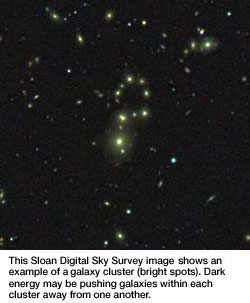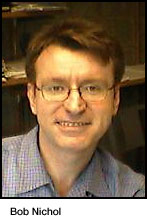|
|
||||
|
|
Carnegie Mellon Scientist Bob Nichol Plays Key Role in Discovering Evidence for Dark Energy � 
Carnegie Mellon astrophysicist Bob Nichol and collaborators from the University of Pittsburgh have announced their discovery of dark energy's "shadow" on the ancient cosmic radiation, a relic of cooled radiation from the Big Bang. Nichol worked with Andrew Connolly and Ryan Scranton of the University of Pittsburgh's Department of Physics and Astronomy. Nichol appeared on the David Letterman Show July 28 and their report was covered by the New York Times, the New Scientist and other national outlets.
The Pittsburgh-based investigators, working with other astronomers across the country, helped find an imprint of dark energy by correlating millions of galaxies in the Sloan Digital Sky Survey (SDSS) against the cosmic microwave background (CMB) temperature maps from NASA's Wilkinson Microwave Anisotropy Probe (WMAP).
The combination of ground-based optical data (SDSS) and space-based microwave (WMAP) data gave the investigators a new window into the properties of dark energy, according to the team, which also included investigators from Fermilab, University of Hawaii, University of Arizona, and the University of Pennsylvania. Dark energy, a major component of the universe and one of the greatest conundrums in science, is repulsive rather than attractive like gravity. This causes the universe's expansion to accelerate, in contrast to the attraction of ordinary (and dark) matter, which would make the universe decelerate. The investigators found evidence of dark energy through a cosmological clue called the Integrated Sachs-Wolfe effect. As photons (packets of light) from the CMB travel to us from 380,000 years after the Big Bang, they can experience a number of physical processes, including this effect, which is an imprint or shadow of dark energy on microwaves. The Integrated Sachs-Wolfe effect is seen as a tiny change in the temperature of CMB due to a differential gravitational redshift, according to the investigators. The discovery is "a physical detection of dark energy, and highly complementary to other detections of dark energy" notes Nichol, an associate professor of physics at Carnegie Mellon. Nichol likens the Integrated Sachs-Wolfe effect to looking at a person standing in front of a sunny window: "You just see their outline and can recognize them from just this information. Likewise the signal we see has the right outline (or shadow) that we'd expect for dark energy," said Nichol. The researchers had to look at a many millions of galaxies before they could expect to see the effect. In fact, the discoveries were made in 3,400 square degrees of the sky surveyed by the SDSS. Photons streaming from the CMB pass through many concentrations of galaxies and dark matter that form gravitational wells. As they fall into these wells, photons gain energy (just like a ball rolling down a hill). As they come out, the photons lose energy (again like a ball rolling up a hill), according to the investigators. If the depth of the gravitational well decreases while the photon travels through it then the photon would exit with slightly more energy. "If this were true then we would expect to see that the CMB temperature is slightly hotter in regions with more galaxies. This is exactly what we found," said Connolly. Digital images of the microwaves become more blue (i.e. more energetic) as they fall in toward concentrations of galaxies and dark matter and then become more red (i.e. less energetic) as they climb away from them. "This work provides a new way of looking at the universe and might help us determine the nature of the dark energy. This is truly exciting," says Nichol.
Lauren Ward
|
||
|
Carnegie Mellon Home |
||||
 The SDSS is mapping in detail one-quarter of the entire sky, determining the positions and brightness of 100 million celestial objects. It also is measuring the distances to more than a million galaxies and quasars. WMAP is a NASA mission to measure the temperature of the CMB, the remnant heat from the Big Bang. The mission is revealing conditions as they existed in the early universe by measuring the properties of the CMB over the full sky. (
The SDSS is mapping in detail one-quarter of the entire sky, determining the positions and brightness of 100 million celestial objects. It also is measuring the distances to more than a million galaxies and quasars. WMAP is a NASA mission to measure the temperature of the CMB, the remnant heat from the Big Bang. The mission is revealing conditions as they existed in the early universe by measuring the properties of the CMB over the full sky. (